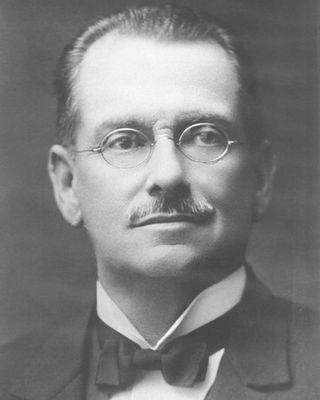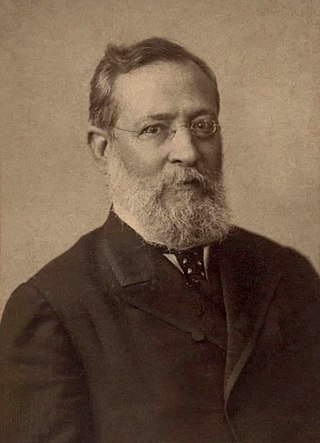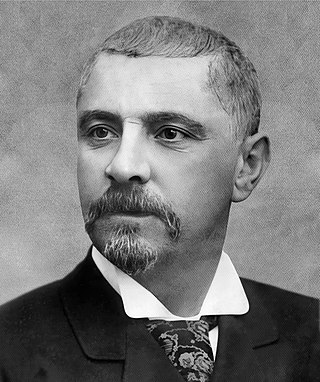
Porto Alegre is the capital and largest city of the Brazilian state of Rio Grande do Sul. Its population of 1.3 million inhabitants (2022) makes it the 11th-most populous city in the country and the center of Brazil's fifth-largest metropolitan area, with 4.4 million inhabitants (2010). The city is the southernmost capital city of a Brazilian state.

The Federal University of Rio Grande do Sul is a Brazilian public federal research university based in Porto Alegre, Rio Grande do Sul. UFRGS is among the largest and highest-rated universities in Brazil, having one of the largest number of scientific publications. From 2012 to 2019, the university was elected as the best federal university of Brazil. UFRGS has over 31,000 undergraduate students, over 12,000 graduate students, and more than 2,600 faculty members. As a Brazilian public federal institution, students do not pay tuition fees to enroll in courses offered by the university.

Augusto Pestana was a Brazilian engineer and politician. Born in Rio de Janeiro, Pestana moved in the late 1880s to Rio Grande do Sul, Brazil's southernmost state, where he would become a specialist in railroad engineering and public administration, as well as one of the main leaders of the Republican Party of Rio Grande do Sul (PRR).

Júlio de Castilhos is a municipality of the central part of the state of Rio Grande do Sul, Brazil. The population is 19,224 in an area of 1,929.38 km². Its elevation is 529 m, 516 m at the meteorological station and 503.81 m at the railway station. It is located 627 km west of the state capital of Porto Alegre, northeast of Alegrete. The city is considered the Brazilian capital of the Charolais cattle.

Pinhal Grande is a municipality of the central part of the state of Rio Grande do Sul, Brazil.

Júlio de Castilhos Museum is a museum located in the city of Porto Alegre. It is the oldest museum in Rio Grande do Sul state.

The Federalist Revolution was a civil war that took place in southern Brazil between 1893 and 1895, fought by the federalists, opponents of Rio Grande do Sul state president, Júlio de Castilhos, seeking greater autonomy for the state, decentralization of power by the newly installed First Brazilian Republic.

Centro Histórico is a neighborhood of the city of Porto Alegre, the state capital of Rio Grande do Sul in Brazil.
Vicentino Prestes de Almeida was a Brazilian paleontologist.
Irajá Damiani Pinto, was a Brazilian paleontologist and professor at the Federal University of Rio Grande do Sul, a member of the Brazilian Academy of Sciences, and a two time president of the Brazilian Geological Society.

The Legislative Assembly of Rio Grande do Sul is the regional parliament of Rio Grande do Sul, a federative unit in Brazil. It has 55 state deputies elected every 4 years.
The following is a timeline of the history of the city of Porto Alegre, in the state of Rio Grande do Sul, Brazil.

Rodrigo Maroni is a Brazilian politician, as well as a yoga instructor and animal rights activist. He has spent his political career representing Rio Grande do Sul, having served in the state legislature since 2019.

The governor of Rio Grande do Sul is the head of government of the state's executive branch, assisted by his secretaries, whom he freely chooses. Elected by absolute majority in universal suffrage, together with the vice-governor, his term lasts four years; since 1997, reelection has been possible, and although all have sought it, none has succeeded. The current governor is Eduardo Leite, since January 1, 2023.

The history of Rio Grande do Sul begins with the arrival of Man in the region, around 12,000 years ago. Its most dramatic changes, however, occurred in the last five centuries, after the discovery of Brazil. This most recent period took place amid several external and internal armed conflicts, some of which with great violence.

Praça Marechal Deodoro, better known as Praça da Matriz, is a historic square in the city of Porto Alegre, the capital of the Brazilian state of Rio Grande do Sul. It is located in the heart of the city, in the Historic Center, and has existed since the early days of the capital. It is listed by the National Institute of Historic and Artistic Heritage.

Gaspar da Silveira Martins was a Brazilian magistrate and politician. He was a provincial and general deputy, provincial president, minister of finance and senator of the Empire of Brazil from 1880 to 1889.

Castilhism was the political current established by Júlio de Castilhos with the creation of the Rio Grande do Sul Constitution of 1891. It was the guiding principle of the Estado Novo, Getúlio Vargas' dictatorial period. It is the ideology behind the Brazilian labour movement, which elevated Castilhism to national importance.
Laura Soares Sito Silveira, or simply Laura Sito is a Brazilian politician affiliated with the Workers’ Party (PT), being both the first Black woman and the youngest state deputy of the Rio Grande do Sul Legislative Assembly.















